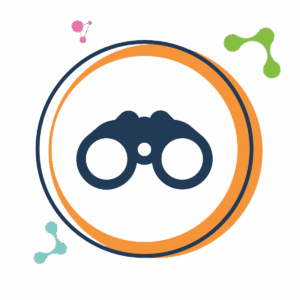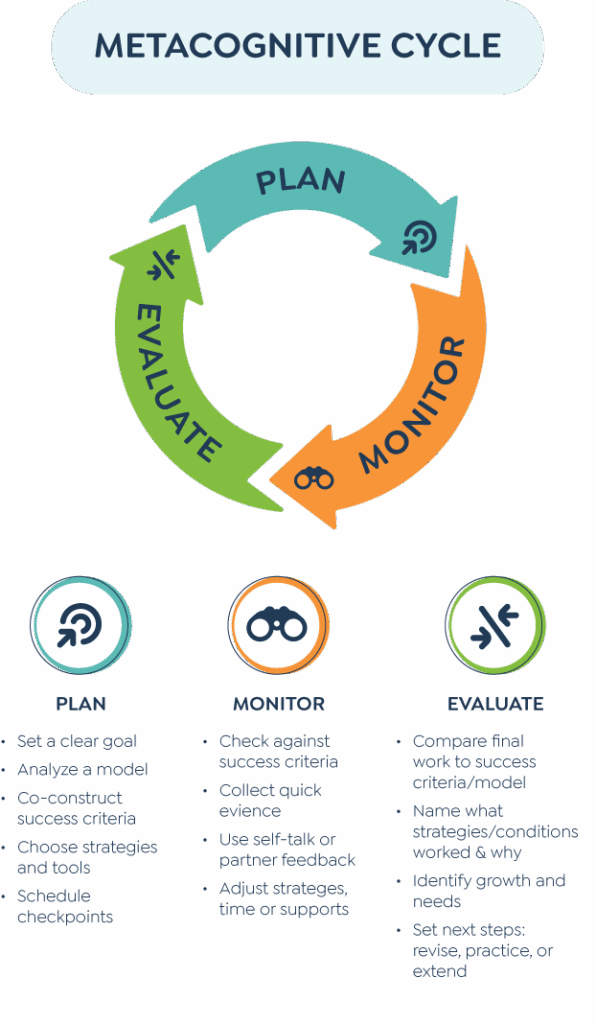Imagine reclaiming 5 to 6 hours of collaborative planning time every 3–4 weeks—the equivalent of an entire professional-learning day—simply by automating what typically takes the longest: analyzing student evidence, identifying misconceptions, and designing targeted next steps.
In a traditional PLC cycle, teachers teach, assess, respond, and reassess—often spending hours sorting through 100 Claim-Evidence-Reasoning (CER) responses just to locate patterns and plan re-teaching. With the AI-PLC Agent™, that same analysis can happen in minutes, allowing teams to focus their time where it matters most: responsive instruction and feedback that accelerates learning.
PLC Inquiry Through Metacognition
The MetaCycle is a PLC inquiry cycle aligned to the four essential PLC questions. We call it the MetaCycle because it’s a metacognitive process—one that makes thinking visible, purposeful, and actionable for both students and teachers.
At its core, metacognition involves three recursive phases:
- Planning: Clarifying learning intentions, setting goals, and anticipating strategies for success.
- Monitoring: Checking understanding in real time using feedback, peer dialogue, and success criteria to stay on track.
- Evaluating: Reflecting on outcomes—what worked, what didn’t, and how thinking and performance have changed.
The MetaCycle embeds this process at every level of PLC inquiry. Teachers and students engage in evidence analysis, feedback, and goal setting using the same cognitive moves: planning next steps, monitoring progress, and evaluating growth. This recursive structure allows students to become assessment-capable learners while educators become inquiry-driven practitioners.
What Does It Mean to Be Assessment-Capable?
Assessment-capable learners are students who can answer three key questions with clarity and confidence:
- Where am I going? (They understand the learning goal and success criteria.)
- How am I going? (They can monitor progress and use feedback to improve.)
- Where to next? (They can set new goals and apply strategies to transfer learning.)
When students become assessment-capable, they develop agency—the belief that their effort and strategies directly influence outcomes. They move from being passive recipients of grades to active stewards of their own learning, capable of self-regulation, goal setting, and reflective growth. Within the MetaCycle, this agency is cultivated systematically through cycles of feedback, reflection, and deliberate practice.
By aligning the PLC cycle with metacognition, schools cultivate self-regulated learners who can articulate their thinking, transfer strategies across tasks, and take ownership of their growth. That’s why the MetaCycle doesn’t just accelerate learning—it transforms how students understand themselves as learners and empowers them to act with agency.
Estimated Time Savings per PLC Cycle (3–4 Weeks)
| Task Type | Traditional
PLC Time |
AI-PLC Agent™ | Time Saved |
% Efficiency Gain |
| Unpacking Standards & Writing Success Criteria
|
60–90 min | 10–15 min | 50–75 min | ~80% |
| Analyzing Student Work (EAA Framework)
|
120–150 min | 15–25 min | 100–125 min | ~85% |
| Planning Guided Practice Lessons
|
60–90 min | 10–20 min | 50–70 min | ~80% |
| Writing Mastery Goals / Reports
|
45–60 min | 5–10 min | 40–50 min | ~85% |
Total Savings per PLC Cycle: 5–6 hours
Total Savings per Year (8–10 cycles): 40–60 hours
ROI per Teacher (at ~$50/hour): $2,000–$3,000 in time value
Alignment Snapshot: Metacognition and the 4 PLC Questions
|
PLC Question |
Metacognitive Phase |
Key Action |
| What do we want students to learn?
|
Planning | Clarify learning intentions and success criteria |
| How will we know if they’ve learned it?
|
Monitoring | Use feedback, success criteria, and evidence to check understanding |
| How will we respond when they haven’t learned it?
|
Evaluating & Planning | Analyze misconceptions, adjust instruction, set next goals |
| How will we extend learning for those who already have?
|
Evaluating & Planning | Design transfer tasks and enrichment grounded in reflection |
The MetaCycle transforms PLCs from meetings about data to inquiry communities where educators and students alike think about their thinking—strengthening agency, efficacy, and equity at every step.
Each MetaCycle includes three key reflective phases—where both teachers and students analyze student perception data (self-peer assessment, reflection, goal setting, etc) alongside performance evidence to understand growth and guide instruction. The AI-PLC Agent™, our new app, supports this work by helping teachers interpret patterns in student thinking and design next steps.
 Phase 1: Building Clarity and Teaching for Transfer
Phase 1: Building Clarity and Teaching for Transfer
The cycle begins with clarity and immersion as teachers introduce the competency bundle and unpack the success criteria with students, showing what high-quality performance looks like across multiple product types:
- Quick writes that capture spontaneous thinking
- Graphic organizers that map key ideas
- Constructed responses that demonstrate reasoning
- Multiple-choice items that test precision and transfer
Students compare these formats to see that each is simply a different way of representing learning. For example:
When I identify a theme in a story (RL.2), I can show it through a short paragraph, a diagram, or by explaining a character’s change (RL.3).
This comparative analysis develops transfer awareness—students recognize that one set of skills applies across many forms of expression (Hattie, 2023; Clarke, 2021).
Pre-Assessment: Then, students complete a pre-assessment tied to the competency bundle. For example, in a cycle focused on RI.2 and RI.5, students might read two short informational texts and explain how text structure helps reveal the main idea.
Students also complete a self-assessment, rating their confidence with each success criterion and describing their strategy use.
Both artifacts, the performance task and self-assessment, are uploaded to the AI-PLC Agent™, which analyzes patterns between student perception and performance data (Bloomberg & Wells, 2025). For example, a learner might believe they are proficient at identifying the main idea (RI.2), yet their response reveals difficulty connecting supporting details. This discrepancy signals where to target instruction.
AI-PLC Agent™ Outputs for Teachers
The AI-PLC Agent™ provides clear, usable outputs, including:
- Performance vs. Perception Comparison Reports: Visuals showing where student confidence aligns or misaligns with actual performance.
- Competency Heat Maps: Highlighted areas of strength and growth across standards (e.g., strong in RL.2, needs support in RL.3).
- Student Grouping Suggestions: Small-group configurations based on shared needs or perception gaps.
- Glow and Grow Feedback: Each student receives asset-based ‘glow and grow’ feedback anchored in success criteria.
- Instructional Recommendations: Targeted strategy banks, mini-lesson prompts, and scaffolds drawn from the evidence.
By the end of Phase 1, teachers and students can answer:
Where am I now in my understanding of this competency, and what’s most important for me to learn next?
 Phase 2: AI Feedback and Deliberate Practice
Phase 2: AI Feedback and Deliberate Practice
The Mid phase activates the power of feedback and focused practice. Teachers use AI-PLC Agent™ insights to launch small-group conferences, giving each student personalized feedback while helping them set a WIN Goal (What I Need) (Bloomberg & Wells, 2024).
Examples:
I will focus on describing how the setting influences a character’s response (RL.3).
I will explain how headings and bold words help readers find key ideas (RI.5).
Students then engage in a week or two of deliberate practice, grounded in principles they understand (Ericsson, 2016; Hattie, 2023):
- Focus: Practice one skill at a time.
- Feedback: Apply input immediately.
- Reflection: Monitor progress and adjust strategy.
- Stretch: Work in the learning zone, not the comfort zone.
Teachers use both AI reports and student reflections to design targeted mini-lessons, guided practice sessions, and strategy groups. Students continuously track their WIN Goals, review exemplars, and confer with peers about strategy use. The classroom becomes a living laboratory of feedback and growth (Wiliam, 2018).
Mid-Assessment: Then, students complete a mirrored mid-assessment task aligned to the competency bundle. For example, in a cycle focused on RI.2 and RI.5, students might read two short informational texts and explain how text structure helps reveal the main idea, just like they did for the pre-assessment.
 Phase 3: Feedback, Revision, and Transfer
Phase 3: Feedback, Revision, and Transfer
In Phase 3, students complete a final task that mirrors the pre-assessment and again submit both a performance and a self-assessment. The AI-PLC Agent™ compares pre-, mid-, and post-cycle data to reveal patterns in:
- Academic Growth: Improvement on targeted success criteria.
- Perception Accuracy: Growth in metacognitive accuracy (how well students understand their own learning).
- Strategy Use: Evidence of transfer and self-regulation.
For example, students may demonstrate growth in connecting text structure to main idea (RI.2/RI.5) and show a narrower gap between how they rated themselves and how they actually performed — a sign of metacognitive development (Zimmerman, 2002).
The AI-PLC Agent™ generates updated Instructional Output Reports for PLCs, including:
- Cycle Reflection Dashboards: Summaries of small group trends.
- Next-Step Guidance: Suggested focus areas for the next MetaCycle.
- Glow and Grow Reports: Clear feedback statements highlighting what students are doing well (glows) and what specific skills or strategies they should strengthen next (grows). Teachers and students use these reports during revision to support goal setting and deeper reflection.
Students study their own growth data with the teacher, reflecting on what changed and why. One student might say:
I used to write about what characters did. Now I explain why they did it, and that shows the theme.
That moment of understanding is the heartbeat of the MetaCycle.
Why It’s Called the MetaCycle
The MetaCycle is called Meta because it puts metacognition—thinking about one’s thinking—at the center of learning (Flavell, 1979; Bloomberg, Wells, & Caccese, 2025).
Each rotation moves students through three core questions:
- Planning: What’s my goal and strategy?
- Monitoring: Is my approach working? How do I know?
- Evaluating: What did I learn, and how can I apply it elsewhere?
Each cycle strengthens both clarity and confidence. Learning doesn’t loop; it spirals upward, producing independent, reflective learners who can talk about their growth with evidence and purpose.
Why It Matters
When teachers look at student perception data alongside performance evidence, they gain a 360-degree view of learning. The AI-PLC Agent™ helps educators make thoughtful instructional decisions, and students begin to see feedback as fuel rather than judgment.
By embedding deliberate practice, reflection, and AI-driven insight into each phase, the MetaCycle transforms classrooms into communities of growth.
When a student reflects and says,
“I didn’t just get better, I know why I got better,” that’s metacognitive clarity.
That’s the MetaCycle—where technology supports humanity and reflection fuels growth.
Join Dr. Paul Bloomberg and Isaac Wells for a Free One-Hour AI-PLC Agent™ Demo
Experience how AI-Powered PLC Protocols bring the MetaCycle to life, helping teams turn evidence into clarity, reflection, and action. See how asset-based feedback fuels teacher agency, accelerates learning habits, and leads to meaningful outcomes for every student.
Reserve your spot today and be part of the next wave of collaborative learning.
References
- Bloomberg, P. J., & Wells, I. (2025). AI-Powered PLC Protocols. Mimi & Todd Press.
- Bloomberg, P. J., & Wells, I. Adriaan (2026). Metacognitive Clarity: Think Rigorously. Advance Democracy. Mimi & Todd Press. (forthcoming)
- Clarke, S. (2021). Unlocking Learning Intentions and Success Criteria: Shifting from Product to Process Across the Disciplines. Corwin Press.
- Ericsson, K. A. (2016). Peak: Secrets from the New Science of Expertise. Houghton Mifflin Harcourt.
- Flavell, J. H. (1979). Metacognition and cognitive monitoring: A new area of cognitive–developmental inquiry. American Psychologist, 34(10), 906–911.
- Hattie, J. (2023). Visible Learning: The Sequel. Routledge.
- Wiliam, D. (2018). Embedded Formative Assessment (2nd ed.). Solution Tree Press.
- Zimmerman, B. J. (2002). Becoming a self-regulated learner: An overview. Theory into Practice, 41(2), 64–70.





